#15th century food
Text
“Unusually, Elizabeth (Woodville)’s receiver-general, her chief financial officer, had no record of royal service. In his early thirties, John Forster was the oldest son of an influential London couple – Sir Stephen Forster had been mayor some ten years previously; his wife, Agnes, was well known for her charitable work – and had trained as a lawyer before making an exceptional marriage to Joan, daughter of the powerful London draper Thomas Cook. John’s head for business, and his in-laws’ connections, had taken him into some heady but dangerous company….Whatever the case, Forster’s appointment was a nod to the cabal of London associates who had proved such valuable creditors to Edward (IV), another link between them and the newly remodelled Yorkist family.”
-Thomas Penn, "The Brothers York: An English Tragedy"
#elizabeth woodville#15th century#english history#my post#as EW's receiver-general he apparently often travelled abroad on confidential diplomatic missions for Edward#Forster also seems to have been in contact with Elizabeth in sanctuary in 1483 and was arrested right after Hastings's execution#Richard seems to have regarded him as EW and Hastings's 'go-between'. There almost definitely wasn't a 'plot' between the latter two but#if they HAD hypothetically been in contact (which still wouldn't have automatically amounted to a 'plot' against Richard's life lol)#then Forster would've been the best person to accuse: he was EW's receiver-general; Hastings's good friend; and clearly powerful#(he was kept without food or water for 48 hours until he signed over his stewardship of the St. Albans abbey to William Catesby...yikes)
5 notes
·
View notes
Text
.
#first year PhD stuff has been…first year PhD stuff#which is to say exciting#but also really rough#especially this past week#then all of a sudden yesterday and today I got mysterious packages in the mail#one had a piece of decor from a speciality store that only someone who knows incredibly specific things about my sense of design would buy#like a specific 15th century Persian rug weave pattern that I like#and then the one today was full of food I can’t get where I’m living right now#special chili oil and air dried noodles and imported ingredients#I couldn’t figure out where the hell they were from#because the return adresses were only for companies#and all of the friends/family I asked said they weren’t from them#then I remembered that months ago I mentioned missing that food to my best friend from university#and she’s also the one I showed all my decor plans for this apartment before I moved in#in August#we FaceTime for a few hours every Saturday#and talk by text pretty constantly#but we also live halfway across the world from each other in almost completely opposite time zones#so we still miss actually being together a lot#yeah…I figured out they were from her because she remembered all of these little things I said months ago#and wanted to make me feel better#I’m rambling#but it’s just…I get the mania Keith had about Charlie in moments like this#I love her so much simply for who she is#and the fact that she’s this thoughtful and kind and amazing and can make me this happy even 3k miles away#gives me that same urge to rant about how perfect she is#I adore her to the point of distraction#she’s the Keith to my Charlie and I really couldn’t ask for anything more in the world#not the stones
5 notes
·
View notes
Text
#SCA#recipe#medieval food#cooking#history#food history#food#foodblogger#15th century#foodstagram#archaeogastronomy#historicreenactment#recipes#medieval#yum#tasty#foodlover#ediblehistory#culinaryhistory#foodhistorian
6 notes
·
View notes
Text
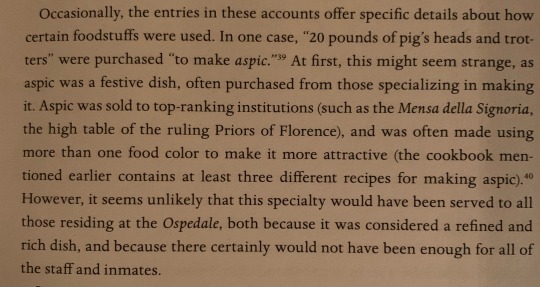


Living my best “oh man deep diving down the early modern food hole again” life with some Allen Grieco essays and beef heart
4 notes
·
View notes
Text
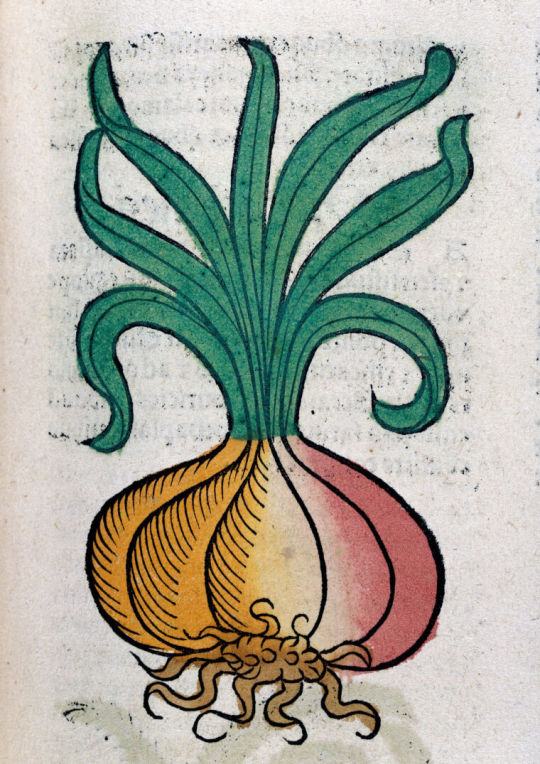
Onion from Ortus sanitatis, 1491
via Wellcome Collection
0 notes
Text
ugh
#look i know this sounds ungrateful when someones cooking for me#but i reqlly dont understand why were eating literal hot gruel in the middle of a heatwave#like fucking 15th century monks#this is the food you give to sick babies#why is my mum so wedded to cooking indian food#why cant we eat literally fucking anything else#via shitposts#seriously you cannot comprehend the grimness
0 notes
Text
I think the budding/green blossom item from Dark Souls is based on primrose (primula vulgaris) a medicinal herb native to Europe which was commonly used to cure fatigue in medieval times

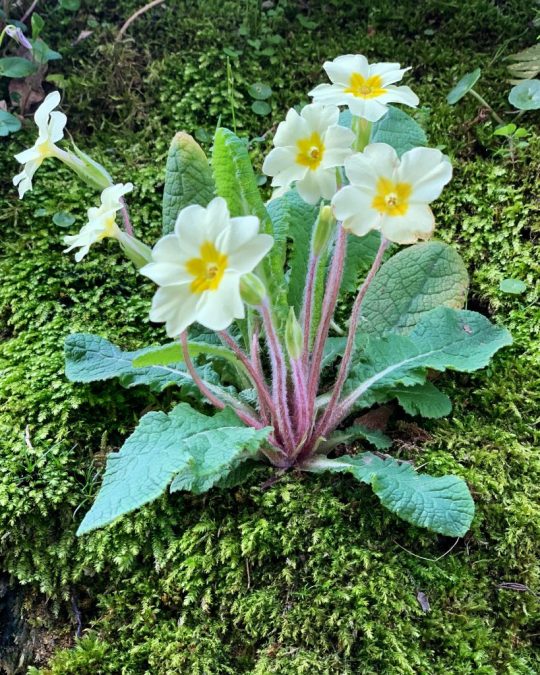

primrose was commonly used in food and teas and was believed to harness healing properties from the sun and was used to ward off illness and melancholia. the 15th century Hortus Sanitatis states that "airy spirits dread the primrose’s sun-given power and will cease their torment" when placed near the heart.


primrose was featured in various poems, songs and art throughout history and has since become a protected species.
the plant is so valuable that harming or even picking the flowers is considered a serious crime in most countries.
#leafie speaks#thanks for coming to my tedtalk#I just talk about plants in videogames now#dark souls#plants in gaming#leafie plants
302 notes
·
View notes
Note
hii! im sorry if u’ve done this before or maybe makes u uncomfy but what about spence x fem!reader that is of a different culture (maybe a part of europe if ur okay with that, or just a different region of the us?) and he begs her to show him parts of her culture like music, food, literature or something? thank u for writing so beautifully!
This is such a cool request thank you! I really only feel comfortable writing for my own culture so I hope you don't mind that. This isn't my best work but I hope that's okay x
“Yes mom, talk to you later”, you hung up your phone call with your mother and as soon as you turned your attention back to your boyfriend he looked at you with wide eyes.
“What?”
“You just spoke-,”
“My native language? Yeah,” you chuckled and sat back next to Spencer who’s eyes still looked as wide as plates.
“What’s the big deal?”
“I’ve just never heard you speak it before.”
“Oh, really? Well I don’t really use it around you don’t I?”
“No… can you though?”
“You want me to speak to you in Estonian?”
Spencer nodded eagerly, “It couldn’t hurt to know a few words.”
You smiled and rested your head on Spencer’s shoulder, “Do you wanna know anything else besides the language?”
A few hours in and Spencer’s interest in your culture only seemed to grow. He learned a few words and asked about the most widely known literature, which also ended up with you talking about one of your favorite book series, an apothecary in the 15th century who helped to solve crimes, which really seemed to peak his interest and you said you’d try and get the English copies for him. And to your surprise he said he’d try and read the ones in the original language, which you did find endearing at first and thought that it could be tricky, but knowing Spencer’s memory he could probably learn the language in a week. You chuckled at his enthusiasm and it made you smile because something you were looking forward to was listening to his little accent.
After some time you finally arrived at the topic of music and you showed Spencer some of your modern favorites and a few classic hits. After a few tunes you landed on one of the classic tunes that made Spencer take your hand and pull you up to dance with.
“So, what did you think so far?”
“I liked it, yeah, you have an interesting culture.”
You smiled and kissed his cheek, “Anything you liked in particular?”
“Hmm I don’t know… you maybe?”
Both of you chuckled and you smiled when Spencer tried to say “I love you” in your native language and pecked his lips, “It’s a good first try.”
Taglist: @radioactiveinvisible @whoisspence @sreidisms @lanascinnamongirls @luvkatryna @sp3ncelle @iluvreid @khxna @keiva1000 @indigosamsblog
If you want to be a part of my taglist go here!
You can find my masterlist here!
My requests are open so feel free to send one in! (SFW only)
#spencer reid#spencer reid au#spencer reid x gn reader#spencer reid x gn! reader#spencer reid imagine#spencer reid scenario#spencer reid oneshot#spencer reid one shot#spencer reid headcanon#spencer reid headcanons#spencer reid hcs#spencer reid hc#spencer reid fanfiction#spencer reid fanfic#spencer reid fic#spencer reid blurb#spencer reid drabble#spencer reid dialogue#spencer reid fluff#spencer reid angst#spencer reid x reader fanfiction#spencer reid x you#spencer reid x y/n#criminal minds fanfiction#criminal minds headcanon#criminal minds x reader#criminal minds imagine#criminal minds
91 notes
·
View notes
Text

Stele fragment depicting King Thothmes III bearing the warrior crown and uraeus, presenting food offerings to the god Amun-Re
circa. 15th century BC
Located in the Israel Museum
#ancient egypt#ancient history#egyptian hieroglyphs#egyptian art#archaeology#egyptian history#egyptian mythology#egyptian gods
302 notes
·
View notes
Note
Do you have any recommendations for books about the everyday lives of medieval people? The last two that I’ve read were just disappointing, leaning far more into sensationalism than anything, and not taking into account the changes in worldview and society between then and now. I love everyday history of how people went about their lives, from how they made breakfast and what they wore, to the games they’d play to pass time and what they thought of their place in the universe. I love your historical posting and was curious if you had any recommendations for non-disappointing books to read! (I read better in English than German, but either would be appreciated!)
Cool to hear you are interested in 'domestic history' as it is often called!
I read these kinds of books mostly in german as I am interested in central european medieval times, as most english books are about britain and france. So I am sorry, most of this stuff is German.
Personally I was very, very happy with 'Wien in Mittelalter' by Peter Csendes & Ferdinand Opll, which is as the title says about Vienna in medieval times (from ~900 until 1529, which is the date set as the end of the medieval times in austria). First half is a timetable for each year, based on documents found in the archives to state what happened. Not only what kings and dukes did, but also e.g. 'Frenz sued his neighbour because his window is built wrong'. Tells you a lot about things people cared about. Second half describes in detail how e.g. the city was divided, how it was governed, how people lived etc. I really, really liked it, but it is mostly about Vienna and its Bürger and thus does not go into detail of the world beyond.
In addition to that, speaking of Vienna, there is the Geschichte Wien Wiki, which is one of the best history wikis in the world! So much details and also images of a lot of maps and stuff, it is great!
Another book I am currently reading (and loving) is also German, called 'Unerhörte Frauen' by Henrike Lähnemann and Eva Schlotheuber, and is about medieval nuns, mostly of the late 15th century in Germany. It discusses diaries of nuns and also explains how they lived, how the cloister was set up, how their education looked like, etc. It is really nice and it is very well researched, putting attention to often ignored women!
When it comes to food I generally read the actual recipe books from the time, as it is the best representation for it. There are also a lot of blogs from reenactors talking about it. For example this blog where some of my friends are involved, focused in 14th century cooking (also german).
I also recommend this blog by an Austrian reenactment group, where they talk about a lot of cool medieval topics. They are very passionate and have a lot of references (also German but have some posts also in english)
Going more specific and maybe boring there is this 7 book set about the finds of excavations in London. I have two of them by now, and it is quite cool to see what people used, how it looked like, what was common, what stuff was made of. But it is very thechnical/academic, so maybe not what you may be looking for. My reenactment friends and I love these books because it helps a lot in recreating stuff authentically.
Otherwise I read not that many books about medieval life, I mostly read research stuff and read medieval literature (I made a long post about it a while back) and talk with my nerdy friends about it
I hope this is useful!
Any of my followers, feel free to add if you know cool books and stuff :)
81 notes
·
View notes
Text
“A falling down of the whole soul.”
The main physical symptom of scurvy is the disintegration of the body. The skin begins to break. It starts with little blood blisters and develops into full-scale ulcers. The gums begin to putrefy and become black. Bones that had previously broken rebreak. Old wounds open up.

This is because one of the major effects of scurvy is that the body can no longer produce collagen, the glue of the body’s cells. The cartilage, especially around the thorax, begins to disappear. That’s why people who had scurvy creaked and rattled.

The psychological facts were caused by the disintegration of the nervous structure of the brain. The function of vitamin C is to scavenge free radicals, which are what you could call the waste matter of neuronal activity in the brain, which causes oxidation. Oxidative stress occurs when there isn’t enough vitamin C to get rid of the free radicals which are, in effect, blocking the synapses, destroying the effectiveness of the neurotransmitters or causing them to operate in intermittent and explosive ways. And when the neurotransmitters serotonin and dopamine don’t function properly, the brain starts producing hallucinations.

Dreams become very vivid. And what these dreams produce is an image so exact, and brilliant, of what the body needs: namely, food. When you wake up, or when the hallucination disappears, and you find the food is not there, you are totally devastated. Thomas Willis, an expert on scurvy in the 17th century, called it “a falling down of the whole soul.”

You call scurvy “the disease of discovery.” Map out its causes and the scale of its ravages in the great sea voyages of the 15th to 18th centuries. An estimated two million seamen died of scurvy during those years.
Simon Worrall interview with Jonathan Lamb for National Geographic
#scurvy#the terror#the terror amc#james fitzjames#henry peglar#william gibson#thomas jopson#history#national geographic#interviews
1K notes
·
View notes
Text
Xiangliu

Image © deviantArt user YunaXD, accessed at her gallery here
[Sponsored by @coldbloodassassin. The xiangliu appears in Guideways through Mountains and Seas as an individual, Xiangliu, who is the minister of the malevolent water god Gonggong. I did consider making it a native or even extraplanar outsider because of that, but ended up going with aberration to stress its connection to nagas. Not that nagas are very aberrant as far as aberrations go...]
Xiangliu
CR 14 NE Aberration
This creature is an oversized serpent with nine heads and slime coating its scales. Its heads are disturbingly humanoid, but still bear fangs and forked tongues.
Xianglius are sadistic water serpents that delight in spreading disease and stagnant water. They are native to swampy lands, and fight violently against any attempt to drain such swamps or make them suitable for cultivation. Nearby fields are likely to be subject to their attacks, including flooded crops, summoned clouds of malarial mosquitoes and fouling wells and springs. Xianglius sometimes find allegiances with evil druids, daemons of pestilence and famine, or even gods of water who are hostile to civilization.
A xiangliu rarely hesitates to fight. Their bites are not fully venomous, but carry a foul slime that renders creatures bitten weak and queasy. They can spit jets of water with lethal force, and often split their attacks, biting creatures up close while barraging enemies that are more distant. Fighting a xiangliu is often quite frustrating, as the monsters create moats of mud and water to slow anyone approaching on foot, and can manipulate water to isolate and capsize boats. Wise adventurers approach a xiangliu’s lair from the air.
Despite their nine heads, a xiangliu has only one personality; peevish, cruel and sadistic. They are notorious gluttons; one legend is that they have nine heads in order to eat nine different meals at the same time. A xiangliu grows to about twenty feet long. Their lifespans are measured in centuries.
Xiangliu CR 14
XP 38,400
NE Large aberration (aquatic)
Init +6; Senses all around vision,darkvision 60 ft., Perception +22, scent
Defense
AC 29, touch 15, flat-footed 23 (-1 size, +6 Dex, +14 natural)
hp 190 (20d8+100)
Fort +13, Ref +15, Will +16
DR 10/magic; Immune acid, disease, poison, sickness and nausea effects; SR 25
Offense
Speed 30 ft., swim 40 ft.
Melee 9 bites +20 (1d6+4 plus sickening slime)
Ranged 9 water jets +20 (1d8 bludgeoning plus push)
Space 10 ft.; Reach 10 ft.
Special Attacks combined arms, mud wave, push (5 ft.)
Spell-like Abilities CL 15th, concentration +20 (+24 casting defensively)
At will—contagion (DC 18), putrefy food and drink
3/day—control water, insect plague
1/day—plague storm (DC 21), transmute rock to mud
Statistics
Str 19, Dex 23, Con 20, Int 18, Wis 19, Cha 20
Base Atk +15; CMB +20; CMD 36 (cannot be tripped)
Feats Blind Fight,Combat Casting, Combat Reflexes (B),Deadly Aim, Great Fortitude, Improved Critical (bite), Lightning Reflexes, Point Blank Shot, Precise Shot, Skill Focus (Stealth), Weapon Finesse
Skills Acrobatics +22, Climb +20, Heal +18, Intimidate +21, Knowledge (arcana, geography) +18, Knowledge (nature) +20, Perception +22, Sense Motive +17, Spellcraft +20, Stealth +24, Swim +28; Racial Modifiers +2 Perception
Languages Aquan, Common, Draconic
SQ amphibious, improved swamp stride, multiheaded reflexes
Ecology
Environment any swamps and aquatic
Organization solitary
Treasure standard
Special Abilities
Combined Arms (Ex) When using a full attack action, a xiangliu can divide its nine attacks up between bites and water jets.
Improved Swamp Stride (Su) A xiangliu can move without penalty through natural or magically manipulated mud, water, or vegetation native to swamp environments.
Insect Plague (Sp) When a xiangliu uses its insect plague spell-like ability, it summons mosquito swarms instead of wasp swarms.
Mud Wave (Su) As a standard action, a xiangliu can create a burst of mud and water in a twenty foot radius centered on itself. All creatures in the area take 14d6 points of bludgeoning damage and are knocked prone. A DC 25 Reflex save halves the damage and negates the prone effect. The area affected by the mud wave becomes difficult terrain for the next minute. A xiangliu can use this ability three times per day, but must wait 1d4 rounds between uses. The save DC is Charisma based.
Multiheaded Reflexes (Ex) A xiangliu gains Combat Reflexes as a bonus feat. It can make as many attacks of opportunity in a round as it has heads.
Sickening Slime (Ex) A creature bitten by a xiangliu must succeed a DC 25 Fortitude save or be sickened for 1 round. Failing additional saves increases the duration of the sickened effect by 1 round per save failed. The save DC is Constitution based.
Water Jet (Su) A xiangliu can spit water from one of its mouths as a standard action, and up to all nine as a full attack. Treat each water jet as a ranged attack from a projectile weapon with a range increment of 20 feet. Attacks with water jets do not provoke attacks of opportunity. A creature struck by a water jet takes 1d8 points of bludgeoning damage and is exposed to the xiangliu’s push attack.
#pathfinder 1e#aberration#xiangliu#hydra#naga#guideways through mountains and seas#chinese mythology#sponsored post
51 notes
·
View notes
Text
lautity fic in which steph is from the 21st century and having a grand old time but then shenanigans occur and she's sent back in time to like, the middle ages or some shit. a historical period where the catholic church was popping (probably, given Things, pre-protestant reformation so 15th century or earlier). she's like shit how do i get food how do i look after myself isn't sexism worse now? i feel like it is. and she runs into this nun. grace chasity. according to my friend there were cases where the nuns weren't told wlw relationships were a sin (not that i believe it is but you get my point) so they would just. have them. and anyway they date, time travel angst (not on sexuality though) and shenanigans ensue
43 notes
·
View notes
Text
Harliean MS 279 (AB. 1430) - Cawdelle Ferry - Wine Sauce or Wine Pudding

Cawdelle Ferry - A 15th Century sauce (or pudding) made from wine, thickened with eggs. It is delicious, and suitable for modern taste.
Original Recipe
.xlvij. Cawdelle Ferry. — Take plkys of eyi-oun Raw, y-tryid fro the whyte ;• jmn take gode wyne, and warme it on j^e potte on a fayre Fyre, an caste ]7er-on plkys, and stere it wyl, but let it nowt boyle tylle it be ]7ikke ; and caste jjer-to Sugre, Safroun, & Salt, Maces, Gelofres, an Galyngale y-grounde smal, & flowre of Canelle; & whan ]>ovf dressyst yn, caste blanke ponder ))er-on.
Interpretated Recipe
47. Caudell Ferry - Take yolks of eggs, raw, separated from the white, then take good wine and warm it on the pot on a fair fire, and caste there-on yolks, and stir it well, but let it not boil till it be thick, and caste there-to sugar, saffron, and salt, maces, gillyflowers and galangal ground small, and flour of cinnamon, and when you dress in, cast white powder there-on.
Recipe can be found here:
#15th century#food history#food#medieval manuscripts#medieval cooking#medieval food#historicfood#historicreenactment#tastyfood#giveitforth
1 note
·
View note
Text

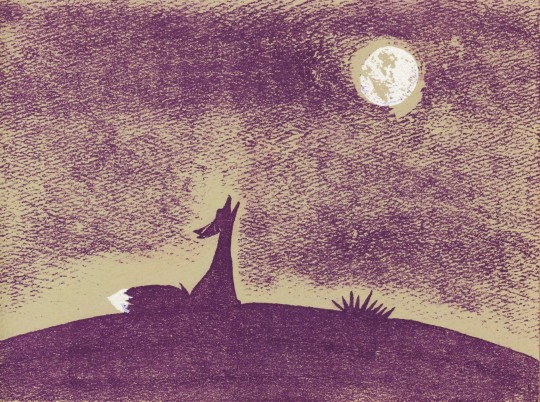
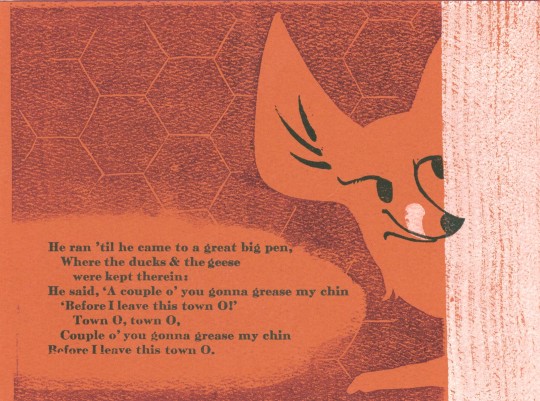


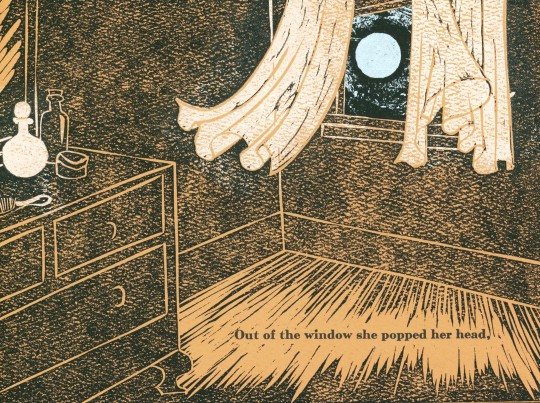


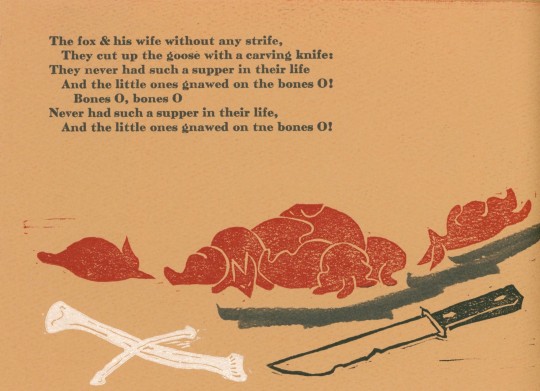


It's Fine Press Friday!
Today's book includes text from an old English folk song with prints by Polly B. Johnson of the Press of the Unseen Unicorn in San Antonio, Texas entitled The Fox. The Fox is a traditional English folk song, the earliest versions of which are from the 15th century and written in Middle English. It is number 131 in the Roud Song Index. This song has also been used and modified throughout the modern age, and has been covered by popular musicians and groups from 1950s to today.
The story is about a fox that goes into a town to terrorize the people and animals living there, while also gathering food for his family living outside the town limits. As the fox goes back to his family, the children exclaim about how wonderful the food he has gathered from the town is, and request that he go back frequently for more exploits.
The Fox was printed with hand-set Masterman type using a Golding Pearl Letterpress on Teton Text Paper, except for the black paper, which is Canson Mi Teintes paper, in an edition of 50 copies. The prints were made using linoleum, wood, and torn chipboard. The cover is made of a rough woven cloth and includes a bone that was boiled, washed, and soaked in Clorox, and dipped in shellac. Our copy is another gift from the estate of our late friend Dennis Bayuzick.
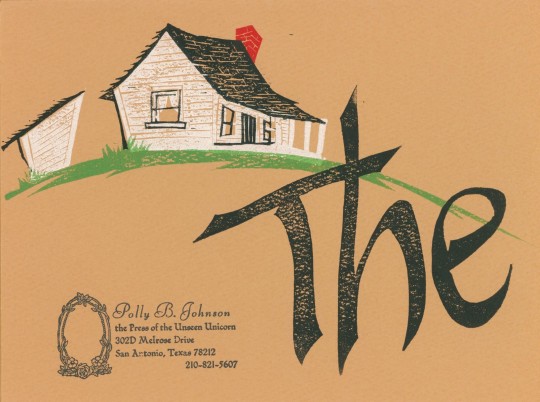

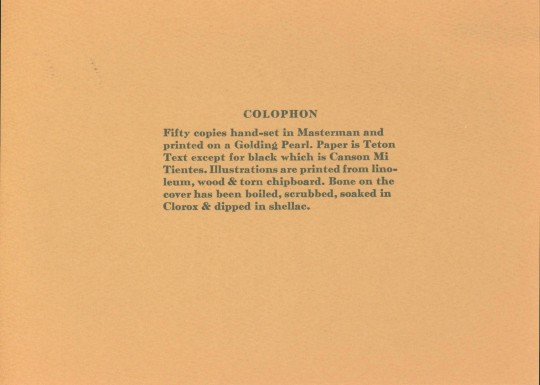
View another book by Polly B. Johnson.
View other books from the collection of Dennis Bayuzick.
View more Fine Press Friday Posts.
– Sarah S., Special Collections Graduate Intern
#Fine Press Friday#fine press fridays#Polly B. Johnson#Press of the Unseen Unicorn#The Fox#english folk songs#folk songs#fine press printing#fine press books#fine press publishing#Masterman type#teton text paper#canson mi teintes paper#linocuts#woodcuts#chipboard print#medieval folk songs#15th century folk songs#roud song index#roud 131#Dennis Bayuzick#Sarah S.
121 notes
·
View notes
Note
Someone in the notes on your post about food in fantasy mentioned connection between at least early modern production of sugar and colonialism and slavery, and while I 100% agree that it's something that should be known, I think that if you want to have lighthearted fantasy setting there are definitely ways to work around this.
Like sugar is also produced from sugar beet. I don't know could it be done without modern equipment (production started at the very end of 18th century so while industrial equipment was primitive it was), but like you may do something with it, like some wizards developing production technology.
In the same vein, crop exchange in the Old World was mostly peaceful, or at least it wasn't due to slavery. Like rice was already grown in Egypt in 1000 BCE and made its way to Spain by 7th century CE. Bananas were grown in Turkey by 15th century CE. And tons of agricultural goods come from West Asia both ways. What I am trying to say is that if your world has equivalent of Americas your Europeans* could have just acquired potatoes and corn without colonization (because they were more ethical than irl or because they didn't have resources for conquest or because American nations were strong enough to stop them). Like potatoes and such are just crops, sailors could have picked them as a supplies and then someone decided to grow them at home.
This is like a suggestion specifically if you want to have a world for costume drama without dealing with heavy themes. I would suggest describing it specifically to point that out, and I can't say that it's very politically aware but definitely not worse than "they just have it" or "yes there are overseas colonies but pay it no mind".
*Because that's usually the case in examples that are discussed, from what I heard East Asian fantasy set in East Asia also suffers from this for the same reason, but I didn't read enough of it to say
Let me say you make real good points and I broadly agree with you. I do think the history of colonialism and where our foods came from is important (I do research that so no doubt). And I also agree that sometimes, those themes are too difficult to board properly, especially in a lighthearted story.
However, in fiction, it's not so much that I want people to do more "clean" ways of getting those crops. Many people told me "well, what if they get it through trade, or what if they got it through magical portals and such" my point is not that you find a "colonialist free" way to have potatoes in your setting, my point is that every crop in real life has a history behind them, and when you place them in your setting, I think you should consider that. Not only because you will learn about real life and its history, but also because of the storytelling potential.
I mean, I do have "worldbuilding fundamentalist" in my bio, and I think even if you don't sketch the entire world, you should at least know where your heroes are. Much of modern fantasy loves to adopt the "medieval" aesthetic, while in fact presenting a world with widespread trade, urbanization, a growing artisan class, etc. (I've done a longer rant about it here). Those things aren't just aesthetic choices, they are different societies that have different dynamics and they do affect the kind of plots and characters you might make on them.
I don't think fantasy should shy away from exploring themes such as imperialism and colonialism, trade and politics, intercultural contact and social change. One reason why I'm so insistent with the theme of crops and trade is that it's because it's emblematic of those issues. Sure, you don't want to explain the potatoes or chocolate in your setting, whatever. Don't you WANT to, though? Don't you want to explore beyond the pseudo-medieval aesthetic, and explore what an American or African -inspired setting might look like? Of course, you could and should also make your own new settings, but exploring actual history, geography, biology (at the broadest term, natural history) will make you a better worldbuilder and a better writer, AND also let you learn more about the world.
Sorry if this rant is a bit unfocused, just woke up from a nap after some wine, but this is why I'm so insistent with the stories that can arise just by considering the crops in your setting. Imagine what else can you write.
26 notes
·
View notes